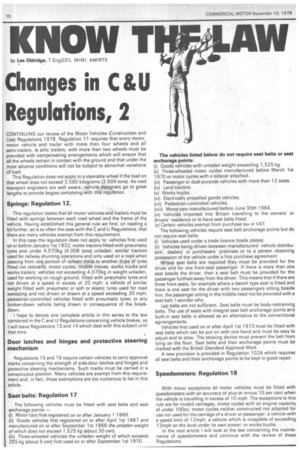Changes in CU Regulations, 2
Page 74

If you've noticed an error in this article please click here to report it so we can fix it.
CONTINUING our review of the Motor Vehicles (Construction and Use) Regulations 1978, Regulation 11 requires that every motor, motor vehicle and trailer with more than four wheels and all semi-trailers, ie artic trailers, with more than two wheels must be provided with compensating arrangements which will ensure that all the wheels remain in contact with the ground and that under the most adverse conditions will not be subject to abnormal variations of load.
This Regulation does not apply to a steerable wheel if the load on that wheel does not exceed 3,560 kilograms (3.504 tons). As road transport engineers are well aware, vehicle designers go to great lengths to provide bogies complying with this regulation.
Springs: Regulation 12.
This regulation states that all motor vehicles and trailers must be fitted with springs between each road wheel and the frame of the vehicle. Having established this general rule we find, on reading a bit further, as is so often the case with the C and U Regulations, that there are many vehicles exempt from this requirement.
In this case the regulation does not apply to: vehicles first used on or before January 1st 1932; motor tractors fitted with pneumatic tyres and under 4,070kg (4.006 tons) unladen; similar tractors used for railway shunting operations and only used on a road when passing from one portion of railway track to another (type of tyres fitted not relevant); motor cycles; mobile cranes; works trucks and works trailers; vehicles not exceeding 4,070kg in weight unladen, used for working on rough ground, fitted with pneumatic tyres and not driven at a speed in excess of 20 mph; a vehicle of similar weight fitted with pneumatic or soft or elastic tyres used for road sweeping and not driven or drawn at a speed exceeding 20 mph; pedestrian-controlled vehicles fitted with pneumatic tyres; or any broken-down vehicle being drawn in consequence of the breakdown.
I hope to devote one complete article in this series to the law contained in the C and U Regulations concerning vehicle brakes, so I will leave Regulations 13 and 14 which deal with this subject until that time.
Door latches and hinges and protective steering mechanism
Regulations 1 5 and 16 require certain vehicles to carry approval marks concerning the strength of side-door latches and hinges and protective steering mechanisms. Such marks must be carried in a conspicuous position. Many vehicles are exempt from this requirement and, in fact, these exemptions are too numerous to list in this article.
Seat belts: Regulation 17
The following vehicles must be fitted with seat belts and seat anchorage points: (i) Motor cars first registered on or after January 1 1965.
(ii) Goods vehicles first registered on or after April 1st 1967 and manufactured on or after September 1st 1966 the unladen weight of which does not exceed 1,525 kg (about 30 cwt).
(iii) Three-wheeled vehicles the unladen weight of which exceeds 255 kg (about 5 cwt) first used on or after September 1st 1970. The vehicles listed below do not require seat belts or seat anchorage points: (i) Goods vehicles with unladen weight exceeding 1,525 kg.
(ii) Three-wheeled motor cycles manufactured before March 1st 1970 or motor cycles with a sidecar attached.
(iii) Passenger or dual-purpose vehicles with more than 12 seats.
(iv) Land tractors.
(v) Works trucks.
(vi) Electrically propelled goods vehicles.
(vii) Pedestrian-controlled vehicles.
(viii) Motor cars manufactured before June 30th 1964.
(ix) Vehicles imported into Britain travelling to the owners' or drivers' residence or to have seat belts fitted.
(x) Certain vehicles exempt from purchase tax or VAT. The following vehicles require seat belt anchorage points but do not require seat belts: (i) Vehicles used under a trade licence (trade plates).
(ii) Vehicles being driven between manufacturers' vehicle distributors', dealers' or purchasers' premises or to a person obtaining possession of the vehicle under a hire purchase agreement.
Where seat belts are required they must be provided for the driver and for one front-seat passenger. If there is more than one seat beside the driver, then a seat belt must be provided for the passenger furthest away from the driver. This means that if there are three front seats, for example where a bench type seat is fitted and there is one seat for the driver with two passengers sitting beside him, the passenger sitting in the middle need not be provided with a seat belt; I wonder why.
Lap belts are not sufficient. Seat belts must be body-restraining belts. The use of seats with integral seat belt anchorage points and built-in seat belts is allowed as an alternative to the conventional agrrangements.
Vehicles first used on or after April 1st 1973 must be fitted with seat belts which can be put on with one hand and must be easy to adjust and to stow. The stowing device must prevent the belt from lying on the floor. Seat belts and their anchorage points must be marked with the British Standard Approval Mark.
A new provision is provided in Regulation 102A which requires all seat belts and their anchorage points to be kept in good repair.
Speedometers: Regulation 18
With minor exceptions all motor vehicles must be fitted with speedometers with an accuracy of plus or minus 10 per cent when the vehicle is travelling in excess of 10 mph. The exceptions to this rule are for invalid carriages, motor cycles with an engine capacity of under 100cc; motor cycles neither constructed nor adapted for use nor used for the carriage of a driver or passenger; a vehicle with a speed limit of 12mph; a vehicle which is incapable of exceeding 12mph on the level under its own power; or works trucks.
In the next article I will look at the law concerning the maintenance of speedometers and . continue with the review of these Regulations.






















































































































































